
Illustrative Math Alignment: Grade 7 Unit 7
Angles, Triangles, and Prisms
Lesson 2: Adjacent Angles
Use the following Media4Math resources with this Illustrative Math lesson.
| Thumbnail Image | Title | Body | Curriculum Nodes |
|---|---|---|---|
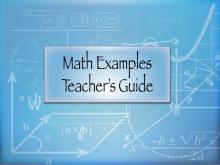
|
MATH EXAMPLES--Teacher's Guide: Circular Area and Circumference | MATH EXAMPLES--Teacher's Guide: Circular Area and Circumference
This set of tutorials provides 23 examples of solving for the area and circumferences of circles and sections of circles. This is part of a collection of teacher's guides. To see the complete collection of teacher's guides, click on this link. Note: The download is a PDF file.Related ResourcesTo see resources related to this topic click on the Related Resources tab above. |
Area and Circumference |

|
MATH EXAMPLES--Teacher's Guide: Polygon Classification | MATH EXAMPLES--Teacher's Guide: Polygon Classification
This set of tutorials provides 36 examples of how to classify polygons based on side and angle characteristics. This is part of a collection of teacher's guides. To see the complete collection of teacher's guides, click on this link. Note: The download is a PDF file.Related ResourcesTo see resources related to this topic click on the Related Resources tab above. |
Definition of a Polygon |

|
MATH EXAMPLES--Teacher's Guide: Quadrilateral Area and Perimeter | MATH EXAMPLES--Teacher's Guide: Quadrilateral Area and Perimeter
This Teacher's Guide provides an overview of the 24 worked-out examples that show how to calculate the area and perimeter of different quadrilaterals. This is part of a collection of teacher's guides. To see the complete collection of teacher's guides, click on this link. Note: The download is a PDF file.Related ResourcesTo see resources related to this topic click on the Related Resources tab above. |
Area and Perimeter of Quadrilaterals |

|
MATH EXAMPLES--Teacher's Guide: Quadrilateral Classification | MATH EXAMPLES--Teacher's Guide: Quadrilateral Classification
This set of tutorials provides 34 examples of the types of quadrilaterals and how to classify quadrilaterals based on the sides and angles. This is part of a collection of teacher's guides. To see the complete collection of teacher's guides, click on this link. Note: The download is a PDF file.Related ResourcesTo see resources related to this topic click on the Related Resources tab above. |
Definition of a Quadrilateral |

|
MATH EXAMPLES--Teacher's Guide: Surface Area | MATH EXAMPLES--Teacher's Guide: Surface Area
This Teacher's Guide provides an overview of the 24 worked-out examples that show how to calculate the surface area of different three-dimensional figures. This is part of a collection of teacher's guides. To see the complete collection of teacher's guides, click on this link. Note: The download is a PDF file.Related ResourcesTo see resources related to this topic click on the Related Resources tab above. |
Surface Area |

|
MATH EXAMPLES--Teacher's Guide: Triangle Area and Perimeter | MATH EXAMPLES--Teacher's Guide: Triangle Area and Perimeter
This set of tutorials provides 40 examples of how to find the area and perimeter of triangles. This is part of a collection of teacher's guides. To see the complete collection of teacher's guides, click on this link. Note: The download is a PDF file.Related ResourcesTo see resources related to this topic click on the Related Resources tab above. |
Area and Perimeter of Triangles |

|
MATH EXAMPLES--Teacher's Guide: Volume | MATH EXAMPLES--Teacher's Guide: Volume
This set of tutorials provides 24 examples of how to find the volume of various 3-dimensional geometric figures. This is part of a collection of teacher's guides. To see the complete collection of teacher's guides, click on this link. Note: The download is a PDF file.Related ResourcesTo see resources related to this topic click on the Related Resources tab above. |
Volume |

|
MATH EXAMPLES--Triangle Area and Perimeter | MATH EXAMPLES--Triangle Area and Perimeter
This set of tutorials provides 40 examples of how to find the area and perimeter of triangles. NOTE: The download is a PPT file. |
Area and Perimeter of Triangles |

|
MATH EXAMPLES--Volume | MATH EXAMPLES--Volume
This set of tutorials provides 24 examples of how to find the volume of various 3-dimensional geometric figures. NOTE: The download is a PPT file. |
Volume |
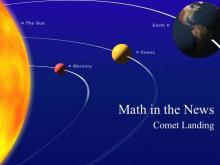
|
Math in the News: Issue 101--Comet Landing | Math in the News: Issue 101--Comet Landing
November 2014. In this issue of Math in the News we examine the historic landing of a spacecraft on an asteroid in space. This is part of the Math in the News collection. To see the complete collection, click on this link. Note: The download is a PPT file.Related ResourcesTo see resources related to this topic click on the Related Resources tab above. |
Applications of Quadratic Functions |
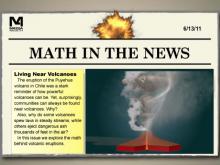
|
Math in the News: Issue 13--Living Near Volcanoes | Math in the News: Issue 13--Living Near Volcanoes
6/13/11. In this issue we explore the volcanic eruption in Chile that resulted in a huge plume of smoke and ash that was miles high. We explore the viscosity of lava that makes such eruptions possible. This is part of the Math in the News collection. To see the complete collection, click on this link. Note: The download is a PPT file.Related ResourcesTo see resources related to this topic click on the Related Resources tab above. |
Volume |
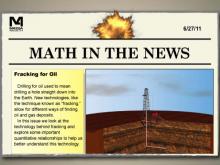
|
Math in the News: Issue 15--Fracking for Oil | Math in the News: Issue 15--Fracking for Oil
6/27/11. In this issue we look at the technology of hydraulic fracking. In particular, we estimate the amount of drilling required for such wells. This is part of the Math in the News collection. To see the complete collection, click on this link. Note: The download is a PPT file.Related ResourcesTo see resources related to this topic click on the Related Resources tab above. |
Volume |
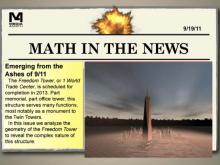
|
Math in the News: Issue 27--Emerging from the Ashes of 9/11 | Math in the News: Issue 27--Emerging from the Ashes of 9/11
9/19/11. To commemorate the 10-year anniversary of the 911, we look at the geometry and architecture of the Freedom Tower, currently under construction. This is part of the Math in the News collection. To see the complete collection, click on this link. Note: The download is a PPT file.Related ResourcesTo see resources related to this topic click on the Related Resources tab above. |
3-Dimensional Figures |

|
Math in the News: Issue 31--Washington Monument: Under Repair | Math in the News: Issue 31--Washington Monument: Under Repair
10/17/11. In this issue we look at the earthquake damage that the Washington Monument recently experienced. Some dramatic footage reveals cracks in the exterior of the monument. This is part of the Math in the News collection. To see the complete collection, click on this link. Note: The download is a PPT file.Related ResourcesTo see resources related to this topic click on the Related Resources tab above. |
Applications of Transformations |
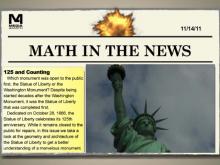
|
Math in the News: Issue 35--125 and Counting | Math in the News: Issue 35--125 and Counting
11/14/11. In this issue we commemorate the 125th anniversary of the Statue of Liberty. We also look at the geometry and architecture of this monument. This is part of the Math in the News collection. To see the complete collection, click on this link. Note: The download is a PPT file.Related ResourcesTo see resources related to this topic click on the Related Resources tab above. |
Surface Area and Volume |
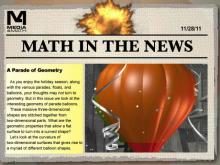
|
Math in the News: Issue 37--A Parade of Geometry | Math in the News: Issue 37--A Parade of Geometry
11/28/11. In this issue we look at the geometry of parade balloons. This is part of the Math in the News collection. To see the complete collection, click on this link. Note: The download is a PPT file.Related ResourcesTo see resources related to this topic click on the Related Resources tab above. |
Surface Area and Volume |

|
Math in the News: Issue 38--December 7, 1941 | Math in the News: Issue 38--December 7, 1941
12/7/11. In this issue we look at the heroic work of salvaging and retrofitting many of the ships sunk during the attack on Pearl Harbor. This is part of the Math in the News collection. To see the complete collection, click on this link. Note: The download is a PPT file.Related ResourcesTo see resources related to this topic click on the Related Resources tab above. |
Surface Area and Volume |
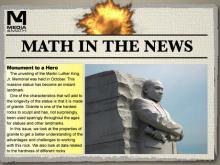
|
Math in the News: Issue 39--Monument to a Hero | Math in the News: Issue 39--Monument to a Hero
12/12/11. In this issue we look at the MLK Memorial and the special properties of granite that presented some design challenges in the construction of the statue. This is part of the Math in the News collection. To see the complete collection, click on this link. Note: The download is a PPT file.Related ResourcesTo see resources related to this topic click on the Related Resources tab above. |
Surface Area and Volume |

|
Math in the News: Issue 42--The Burj Khalifa Tower | Math in the News: Issue 42--The Burj Khalifa Tower
January 2012. In this issue we look at the Burj Khalifa Tower, made popular with the release of the Mission Impossible movie. This is part of the Math in the News collection. To see the complete collection, click on this link. Note: The download is a PPT file.Related ResourcesTo see resources related to this topic click on the Related Resources tab above. |
Applications of 3D Geometry |
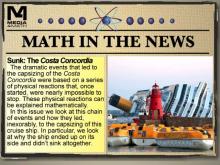
|
Math in the News: Issue 44--Sunk: The Costa Concordia | Math in the News: Issue 44--Sunk: The Costa Concordia
January 2012. In this issue of Math in the News we analyze how the Costa Concordia sank. This is part of the Math in the News collection. To see the complete collection, click on this link. Note: The download is a PPT file.Related ResourcesTo see resources related to this topic click on the Related Resources tab above. |
Surface Area and Volume |
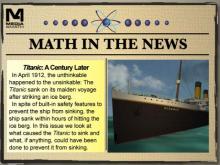
|
Math in the News: Issue 53--Titanic: A Century Later | Math in the News: Issue 53--Titanic: A Century Later
April 2012. In this issue of Math in the News we analyze the sinking of the Titanic. It has been a hundred years, yet the story of the sinkin g of the Titanic still fascinates. This is part of the Math in the News collection. To see the complete collection, click on this link. Note: The download is a PPT file.Related ResourcesTo see resources related to this topic click on the Related Resources tab above. |
Surface Area and Volume |

|
Math in the News: Issue 56--The Freedom Tower | Math in the News: Issue 56--The Freedom Tower
May 2012. In this issue of Math in the News we look at the architecture of the Freedom Tower, now that it has become the tallest building in NYC. This is part of the Math in the News collection. To see the complete collection, click on this link. Note: The download is a PPT file.Related ResourcesTo see resources related to this topic click on the Related Resources tab above. |
3-Dimensional Figures |

|
Math in the News: Issue 73--County Fairs and Funnel Cakes | Math in the News: Issue 73--County Fairs and Funnel Cakes
August 2013. In this issue we look at the geometry of funnel cakes. You'll like the sweet results. This is part of the Math in the News collection. To see the complete collection, click on this link. Note: The download is a PPT file.Related ResourcesTo see resources related to this topic click on the Related Resources tab above. |
Surface Area and Volume |

|
Math in the News: Issue 8--Tornado Damage | Math in the News: Issue 8--Tornado Damage
5/9/11. In this issue we look at tornado season. In particular we study why the swirling winds of a tornado are so damaging. This is part of the Math in the News collection. To see the complete collection, click on this link. Note: The download is a PPT file.Related ResourcesTo see resources related to this topic click on the Related Resources tab above. |
Data Analysis |
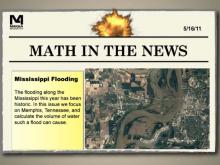
|
Math in the News: Issue 9--Mississippi Floods | Math in the News: Issue 9--Mississippi Floods
5/16/11. In this issue we look at the flooding along the Mississippi. In particular we analyze the flooding along Memphis, Tennessee. We develop a model for predicting the amount of flooding. This is part of the Math in the News collection. To see the complete collection, click on this link. Note: The download is a PPT file.Related ResourcesTo see resources related to this topic click on the Related Resources tab above. |
Volume |

|
Middle School Geometry--Grade 7--Lesson 1: Angle Relationships in Geometry | Middle School Geometry--Grade 7--Lesson 1: Angle Relationships in Geometry This Grade 7 geometry lesson focuses on identifying and solving problems involving angle relationships. Students learn to classify acute, right, obtuse, and straight angles, measure angles using a protractor, and explore relationships among supplementary, complementary, vertical, and adjacent angles. A major focus is understanding angle relationships formed when parallel lines are cut by a transversal. Real-world applications include studying city street grids, with a special emphasis on the geometry of Broadway’s diagonal intersections. The lesson aligns with Common Core Standard CCSS.MATH.CONTENT.7.G.B.5. Multimedia resources from Media4Math.com, including animated clip art, vocabulary definitions, and Google Earth Voyager Stories, support visual learning. |
Definition of an Angle and Geometric Constructions with Angles and Planes |

|
Middle School Geometry--Grade 7--Lesson 2: Area and Circumference of Circles | Middle School Geometry--Grade 7--Lesson 2: Area and Circumference of Circles This Grade 7 geometry lesson focuses on calculating the area and circumference of circles using the formulas A=πr2 and C=2πr. Students explore the relationship between radius, diameter, and circumference, while reinforcing their understanding through coordinate geometry and real-world examples. The lesson is aligned to Common Core Standard CCSS.MATH.CONTENT.7.G.B.4 and emphasizes both conceptual understanding and procedural fluency. Students analyze circle diagrams, scale drawings, and apply formulas in problems involving circular structures such as the U.S. Capitol Rotunda and Pueblo Bonito kivas. Multimedia resources from Media4Math.com include clip art collections, instructional videos, and vocabulary definitions that support key concepts. |
Area and Circumference |

|
Middle School Geometry--Grade 7--Lesson 3: Volume of Cylinders and Cones | Middle School Geometry--Grade 7--Lesson 3: Volume of Cylinders and Cones This Grade 7 geometry lesson introduces students to the formulas and conceptual understanding behind the volume and surface area of cylinders and cones. Aligned to CCSS.MATH.CONTENT.7.G.B.6 and supported by elements of Grade 8 expectations, the lesson includes direct instruction on identifying the radius, height, and slant height of three-dimensional figures. Students review vocabulary using interactive clip art and video definitions from Media4Math.com. Real-world examples feature applications such as soup cans, ice cream cones, party hats, and architectural landmarks like the Leaning Tower of Pisa and the Stamford Cone. Students use visual models, such as nets, to understand surface area and are encouraged to estimate volume through hands-on activities. |
Cylinders and Cones |

|
SAT Math Lesson Plan 27: Quadrilaterals and Polygons | SAT Math Lesson Plan 27: Quadrilaterals and Polygons In SAT Math Lesson 27, students explore the properties of quadrilaterals and other polygons. This lesson covers:
|
Applications of Quadrilaterals and Definition of a Quadrilateral |

|
Test Prep Interactive Quiz--Classifying Angles | Test Prep Interactive Quiz--Classifying Angles
This is part of a collection of self-scoring interactive math quizzes on a variety of topics. To see the complete of these quizzes, click on this link. Note: The download is the teacher's guide.Related ResourcesTo see additional resources on this topic, click on the Related Resources tab.Quiz LibraryTo see the complete collection of Quizzes, click on this link.ary">click on this link. |
Definition of an Angle |

|
Video Transcript: Desmos Geometry Exploration: Types of Angles I | Video Transcript: Desmos Geometry Exploration: Types of Angles I
This is the transcript for the video entitled, Desmos Geometry Exploration: Types of Angles I. In this video tutorial different types of angles are defined, including acute, right, supplementary, and straight angles. Students are shown how to construct these types of angles using the Desmos geometry tools. The Desmos geometry tools can be found at www.desmos.com/geometry. |
Definition of an Angle |

|
Video Transcript: Desmos Geometry Exploration: Types of Angles II | Video Transcript: Desmos Geometry Exploration: Types of Angles II
This is the transcript for the video entitled, Desmos Geometry Exploration: Types of Angles II. In this video tutorial different types of angles are defined, including adjacent angles, complementary angles, supplementary angles, and vertical angles. Students are shown how to construct these types of angles using the Desmos geometry tools. The Desmos geometry tools can be found at www.desmos.com/geometry. |
Definition of an Angle |

|
Video Transcript: Geometry Applications: 3D Geometry | Video Transcript: Geometry Applications: 3D Geometry
This is the transcript for the video of same title. Video contents: In this program we explore the properties of three-dimensional figures. We do this in the context of two real-world applications. In the first, we look at the three-dimensional structure of Mayan pyramids. These stair-step structures provide a unique opportunity to also explore sequences and series. In the second application we look at the Shanghai Tower as an example of cylindrically shaped structures. |
3-Dimensional Figures and Applications of 3D Geometry |

|
Video Transcript: Geometry Applications: 3D Geometry, Segment 1: Introduction | Video Transcript: Geometry Applications: 3D Geometry, Segment 1: Introduction
This is the transcript for the video of same title. Video contents: We visit ancient Greece to learn about the Platonic Solids. This provides an introduction to the more general topic of three-dimensional figures. This is part of a collection of video transcript from the Geometry Applications video series. To see the complete collection of transcripts, click on this link. Note: The download is a PDF file. Video Transcript LibraryTo see the complete collection of video transcriptsy, click on this link. |
3-Dimensional Figures and Applications of 3D Geometry |

|
Video Transcript: Geometry Applications: 3D Geometry, Segment 2: Pyramids | Video Transcript: Geometry Applications: 3D Geometry, Segment 2: Pyramids
This is the transcript for the video of same title. Video contents: Rectangular Prisms. Mayan pyramids are essentially stacks of rectangular prisms. The volume of each successive level is a percentage decrease of its lower neighbor. This introduces the notion of a geometric sequence and series, including an infinite series. |
3-Dimensional Figures and Applications of 3D Geometry |

|
Video Transcript: Geometry Applications: 3D Geometry, Segment 3: Cylinders | Video Transcript: Geometry Applications: 3D Geometry, Segment 3: Cylinders
This is the transcript for the video of same title. Video contents: The Shanghai Tower in China is a stack of cylindrical shapes, where each successive layer is a percentage decrease of its lower neighbor. As with the previous section, this introduces the notion of a geometric sequence and series. |
3-Dimensional Figures and Applications of 3D Geometry |

|
Video Transcript: Geometry Applications: Circles | Video Transcript: Geometry Applications: Circles
This is the transcript for the video of same title. Video contents: In this program we explore the properties of circles. We do this in the context of two real-world applications. In the first, we look at the design of the Roman Coliseum and explore how circular shapes could have been used to design this elliptical structure. In the second application we look at the Roman Pantheon, specifically its spherical dome, to see how the properties of chords and secants help clarify its unique design. |
Applications of Circles |

|
Video Transcript: Geometry Applications: Circles, Segment 1: The Basics of Circles | Video Transcript: Geometry Applications: Circles, Segment 1: The Basics of Circles
This is the transcript for the video of same title. Video contents: We visit Chaco Canyon in New Mexico to explore the circular kivas and in the process discover how circular buildings have been used to study the heavens. This is part of a collection of video transcript from the Geometry Applications video series. To see the complete collection of transcripts, click on this link. Note: The download is a PDF file. Video Transcript LibraryTo see the complete collection of video transcriptsy, click on this link. |
Applications of Circles |

|
Video Transcript: Geometry Applications: Circles, Segment 2: Circles and Arcs | Video Transcript: Geometry Applications: Circles, Segment 2: Circles and Arcs
This is the transcript for the video of same title. Video contents: The Roman Coliseum is a large elliptical structure. Yet, the Romans likely used circular arcs to build it. This segment explores the properties of circles and shows how arcs can be used to create elliptical shapes. |
Applications of Circles |

|
Video Transcript: Geometry Applications: Circles, Segment 3: Chords and Inscribed Angles | Video Transcript: Geometry Applications: Circles, Segment 3: Chords and Inscribed Angles
This is the transcript for the video of same title. Video contents: The Roman Pantheon is a domed structure that shows a keen awareness of the position of the sun throughout the year. The source of light from the top of the dome allows for the exploration of chords, inscribed angles, central angles, and intercepted arcs. |
Applications of Circles |

|
Video Transcript: Geometry Applications: Quadrilaterals | Video Transcript: Geometry Applications: Quadrilaterals
This is the transcript for the video of same title. Video contents: In this program we explore the properties of quadrilaterals. We do this in the context of two real-world applications. In the first, we explore the architecture of Frank Lloyd Wright as an application of squares and rectangles; in particular, we look at his Fallingwater house. In the second application we look at a unique parallelogram-shaped building in Spain, known as the Puerta de Europa. It provides an opportunity to explore the properties of parallelograms and trapezoids. |
Applications of Quadrilaterals |

|
Video Transcript: Geometry Applications: Quadrilaterals, Segment 1: Introduction | Video Transcript: Geometry Applications: Quadrilaterals, Segment 1: Introduction
This is the transcript for the video of same title. Video contents: Stonehenge is best known as a circular structure. But it's the post and lintel construction used that is noteworthy, and this type of construction involves quadrilateral shapes. From the familiar door frames of houses to the majestic entryways of ancient temples, post and lintel construction provides a clear introduction to the nature of quadrilaterals. This segment also describes the key concepts developed throughout the program. |
Applications of Quadrilaterals |

|
Video Transcript: Geometry Applications: Quadrilaterals, Segment 2: Squares and Rectangles | Video Transcript: Geometry Applications: Quadrilaterals, Segment 2: Squares and Rectangles
This is the transcript for the video of same title. Video contents: Frank Lloyd Wright's architectural masterpiece Falling Water is also a stunning assembly of quadrilateral shapes. Some of the rectangular forms in this building seem to defy gravity, as we explore the properties of squares and rectangles that allowed Frank Lloyd Wright to push the envelope of design and structure. |
Applications of Quadrilaterals |

|
Video Transcript: Geometry Applications: Quadrilaterals, Segment 3: Parallelograms and Trapezoids | Video Transcript: Geometry Applications: Quadrilaterals, Segment 3: Parallelograms and Trapezoids
This is the transcript for the video of same title. Video contents: The Puerta de Europa towers in Madrid bring parallelograms front and center. These tilted towers, looking like modern-day towers of Pisa seem to defy gravity, but rely on the stability brought about by its quadrilateral structure. The underlying parallelogram and trapezoidal designs are explored and analyzed. |
Applications of Quadrilaterals |

|
Video Transcript: Geometry Applications: Antiprisms | Video Transcript: Geometry Applications: Antiprisms
This is the transcript for the video: Geometry Applications—Antiprisms. In this video students learn the basics of antiprisms, in the context of New York’s Freedom Tower, which has an antiprism design. They learn the properties of antiprisms, with the focus on those with a square base. This is part of a collection of video transcript from the Geometry Applications video series. To see the complete collection of transcripts, click on this link. Note: The download is a PDF file. Video Transcript LibraryTo see the complete collection of video transcriptsy, click on this link. |
3-Dimensional Figures |

|
Video Transcript: Geometry Applications: Rectangular Prisms | Rectangular Prisms | |

|
Video Transcript: Geometry Applications: What Are Prisms? | Video Transcript: Geometry Applications: What Are Prisms?
This is the transcript for the video: Geometry Applications--What Are Prisms? In this video students learn the basics of prisms and anti prisms. They learn the properties of triangular prisms, rectangular prisms, triangular antiprisms, and rectangular antiprisms. This is part of a collection of video transcript from the Geometry Applications video series. To see the complete collection of transcripts, click on this link. Note: The download is a PDF file. Video Transcript LibraryTo see the complete collection of video transcriptsy, click on this link. |
Rectangular Prisms and Triangular Prisms |
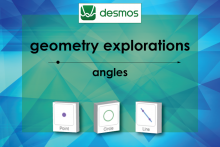
|
Video Tutorial: Desmos Geometry Exploration: Angles | Video Tutorial: Desmos Geometry Exploration: Angles
TopicGeometry DescriptionThis video explains angles and their properties using Desmos geometry tools. It defines angles as formed by two rays meeting at a vertex and measured in degrees or radians. Viewers learn to construct and measure angles, including 0°, 180°, and 360°. Key terms include vertex, rays, and sweep. Applications involve dynamic angle measurement using Desmos tools. |
Definition of an Angle |

|
Video Tutorial: Desmos Geometry Exploration: Types of Angles I | Video Tutorial: Desmos Geometry Exploration: Types of Angles I
TopicGeometry DescriptionThis lesson defines angle types: acute, right, obtuse, and straight, using Desmos tools to measure and create examples. Key terms include angle measure, rays, and straight angle. Applications involve understanding angle properties and classifications for dynamic constructions. |
Definition of an Angle |

|
Video Tutorial: Desmos Geometry Exploration: Types of Angles II | Video Tutorial: Desmos Geometry Exploration: Types of Angles II
TopicGeometry DescriptionAdjacent angles, complementary angles, and vertical angles are explored. Desmos tools help construct and measure these angles, illustrating concepts like angle addition and congruence. Key terms include supplementary, vertical, and adjacent angles. Applications include analyzing intersecting lines and their angle relationships. |
Definition of an Angle |